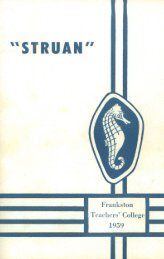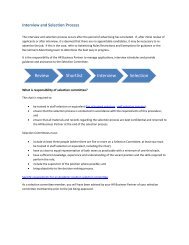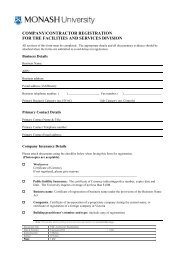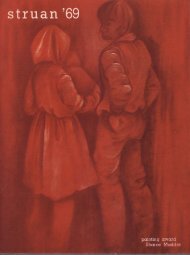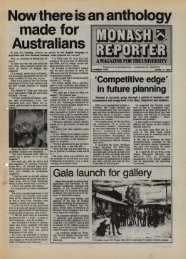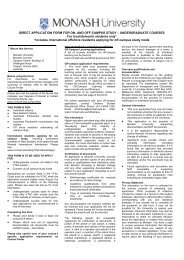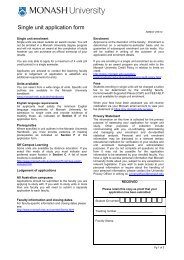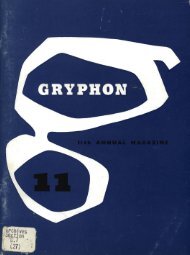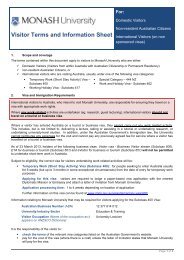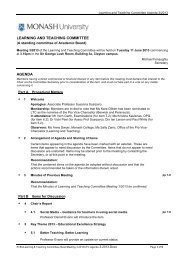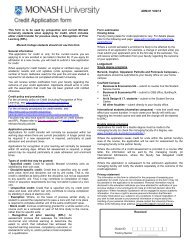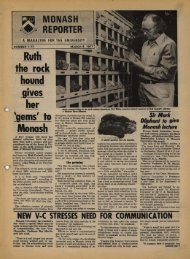Gone (down) but not forgotten - Administration, Monash University
Gone (down) but not forgotten - Administration, Monash University
Gone (down) but not forgotten - Administration, Monash University
You also want an ePaper? Increase the reach of your titles
YUMPU automatically turns print PDFs into web optimized ePapers that Google loves.
Unearthing a<br />
giant's secrets<br />
A combined <strong>Monash</strong>-Odense study of the Giant Gippsland Earthworm<br />
has revealed some secrets of the extraordinary creature's physiology and<br />
biochemistry.<br />
The two-metre animal, which has the cTuorin.<br />
thickness of a human thumb, is <strong>not</strong> only<br />
the world's largest earthworm <strong>but</strong> the<br />
largest terrestrial animal lacking<br />
specialised organs for transporting<br />
oxygen from the external environment<br />
'hrough 'he blood system.<br />
Or Baldwin says the most striking<br />
features of this pigment 3re its extremely<br />
high affinity for oxygen (about 50 times<br />
greater than of human haemoglobin)<br />
and the facilitation of oxygen binding by<br />
high carbon dioxide levels, which is the<br />
<strong>Monash</strong> zoologists Dr John Baldwin<br />
reverse of the situation in vertebrates.<br />
and Mr Fraser Hercus, in collaboration Other studies underway include<br />
with Professor Roy Weber of the measurements of the rate of oxygen<br />
Biology Institute. <strong>University</strong> of Odense,<br />
Denmark, have found the creature has a<br />
closed blood vascular system containing<br />
high concentrations of the oxygenbinding<br />
respiratory pigment, erythroconsumption<br />
by worms placed in artificial<br />
burrows, and an examination of<br />
enzymes involved in metabolic pathways<br />
used to provide energy in worms at rest<br />
and during activity .<br />
• Right Dr John Baldwin unravels a preserved specimen of the Giant Gippsland<br />
Earthworm.<br />
Working is a<br />
health hazard<br />
An Occupational Health Service has<br />
been established at the <strong>University</strong> wilh<br />
the major aim or tackling Repetition<br />
Strain Injury I aU hough it is concerned<br />
with all health problems associated with<br />
working conditions.<br />
The service. which operates from the<br />
<strong>University</strong> Offices, is directed by<br />
Associate Professor Tony Ryan, acting<br />
head of the <strong>Monash</strong> department of<br />
Social and Preventive Medicine.<br />
Consultant ergonomist, Mr David<br />
Caple, and the <strong>University</strong>'s specialist in<br />
organisation and methods, Mr Bob<br />
Lothian, are also involved. and there are<br />
occupational therapy and physiotherapy<br />
staff to assist in the treatment of workrelated<br />
conditions.<br />
• Tony Ryan<br />
8<br />
When it comes to counting,<br />
we've got the numbers<br />
Statistically speaking, Melbourne is<br />
rather well off.<br />
More than half the statisticians in<br />
Australia are trained in the Melbourne<br />
area, and about a quarter of Australia's<br />
statistics research effort is concentrated<br />
there.<br />
And that dominance looks set to continue,<br />
given a recent Federal Government<br />
decision to support the establishment<br />
of a 10int Centre for Statistical<br />
Sciences to be based at <strong>Monash</strong>,<br />
LaTrobe and Melbourne univerSItIes<br />
and the Royal Melbourne Institute of<br />
Technology.<br />
It will be one of seven key centres of<br />
teaching and research which will share<br />
about $3 million in the next three years.<br />
Key centres aim to improve teaching<br />
and research standards, help tertiary institutions<br />
respond to demands for their<br />
expertise and promote co-operation between<br />
higher education and industry.<br />
They are <strong>not</strong> the same as centres of excellence.<br />
which are concerned solely<br />
with pure research.<br />
The joint centre brings together two<br />
initiatives which were already being<br />
undertaken by the institutions.<br />
The first was to offer a coursework<br />
Masters degree in statistics.<br />
The second was the establishment of<br />
statistical consultancies for industry.<br />
The aim is to make the centre selfsupporting<br />
within the three years of the<br />
announced Federal program.<br />
Outcry over<br />
research<br />
on animals<br />
An unannounced visit by RSPCA inspectors<br />
in June threw <strong>Monash</strong> into the<br />
middle of a public controversy over<br />
animal experimentation.<br />
Accusations were made about the<br />
maltreatment of possums and other<br />
animals, and a number of outside<br />
academics and researchers leapt to the<br />
<strong>University</strong>'s defence.<br />
Melbourne <strong>University</strong>'s Professor<br />
Graeme Clark, who developed 'he<br />
bionic ear. said research into the hearing<br />
of possums at <strong>Monash</strong> had been very<br />
valuable, and Dr Margaret Rose from<br />
the Universi'y of NSW praised 'he<br />
general state of the facilities and standards<br />
of care ·in the Physiology department's<br />
animal house.<br />
The RSPCA's behavior over the incident<br />
was censured by the <strong>University</strong><br />
Council, which lodged an official complaint<br />
against the media over the "false<br />
claims and distortion of facts that had<br />
occurred on television and in the press" .<br />
• The director of Animal ServK:es, Dr Jim<br />
Adams, with tom cats born and raised in the<br />
Central Animal House. Photo - Tony<br />
Miller.<br />
NOVEMBER 13, 1985



